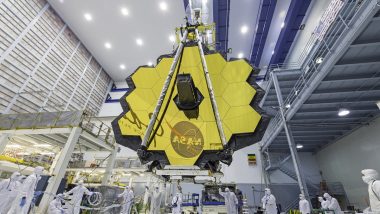James Webb Space Telescope, the largest space telescope ever and the most noteworthy after Hubble is set to be launched on December 24, as per NASA. It has been placed on top of the Ariane 5 rocket which will be launched to space from Europe's Spaceport in French Guiana on Thursday. The European Space Agency (ESA) shared a series of photos showcasing the process of placing the James Webb telescope on the top of the Ariane 5 rocket.
Once the telescope was brought into the final assembly building, it was lifted slowly for about 40m before being manoeuvred on top of the rocket. The technicians then bolted the telescope's launch vehicle adapter down to the rocket. Astronomers Discover 366 New Exoplanets Using Data From The Kepler Space Telescope
The launch of the Telescope, which was scheduled for December 22, had to be postponed to December 24 after engineers noticed a communication issue between the observatory and the launch vehicle system.
According to Karen Richon, a flight-dynamics engineer at NASA's Goddard Space Flight Center, the Webb telescope might have the moon as its next biggest obstacle according to a report in The Atlantic.
According to the report she stated that if any technical failure pushes the launch beyond December, the Earth's satellite might thwart the mission with its gravitational influence. Scientists have already decided a certain trajectory to install the telescope into its orbit and if the Moon comes between that path, its gravity can nudge the former into a completely different route. “It either pulls us back because it wants to try to capture us into orbit, or it gives some acceleration,” Karen told The Atlantic.
Since it is built at an estimated cost of around $10 billion, the telescope will end up being a space junk at a location far away from the planet if the Moon acts as a villain. As the telescope is unserviceable, engineers are not taking any chance with a hurried launch despite the decade-long delay. NASA’s Parker Solar Probe Becomes First Spacecraft To Touch Sun’s Upper Atmosphere ‘Corona’
After the James Webb Telescope is launched, it will take about two weeks to reach its designated orbit from where it will observe the Universe at wavelengths longer than visible light, namely in the near-infrared and mid-infrared. It will remain in a six-month commissioning period after being deployed following its 26-minute ride aboard the Ariane 5 launch vehicle.
(The above story first appeared on LatestLY on Dec 18, 2021 11:16 AM IST. For more news and updates on politics, world, sports, entertainment and lifestyle, log on to our website latestly.com).













 Quickly
Quickly


